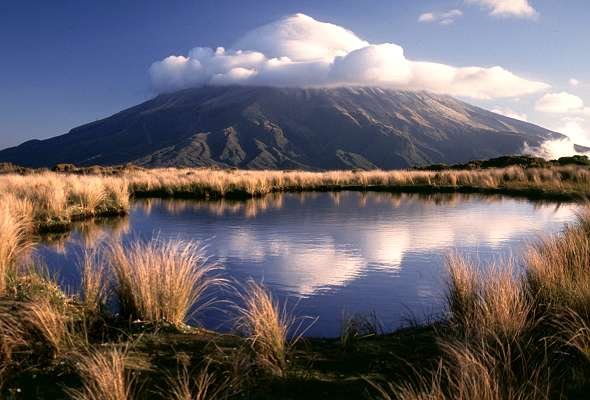Problems, Causes, Solutions to environmental impacts caused by dairy farming:
Problem
- Contamination of ground water by nutrients from cow wastes and nitrogen fertilisers
Cause
- Leaching of nutrients (over supply of nutrients seeping) into soil in paddocks
- Increased stock densities eg Taranaki: 1975 – 1.43 cows/ha compared to 1996 – 1.70 cows/ha
Solution
- Reduce fertiliser application
- Reduce stock densities
- - - - - - - - - - - - - - - - - - - - - - - - - - - - -
Problem
- Contamination of streams, rivers and lakes by nutrients from cow wastes and nitrogen fertilisers
Cause
- Surface run-off from paddocks
- Effluent from cowsheds washed into farm streams from cowsheds
- Increased stock densities
Solution
- Reduce fertiliser applications
- Fence off riparian zones (stream banks) and plant shrubs and trees to trap surface run-off
- Better collection, treatment and disposal of cowshed wastes, eg. Two-pond system (Oxidation Ponds)
- Reduce stock densities
- - - - - - - - - - - - - - - - - - - - - - - - - - - - -
Problem
- Pugging
Cause
- Trampling of grass by cows
- Increased stock densities
Solution
- Create races for the cows to walk on around the farm
- Reduce stock densities
Saturday, September 29, 2007
FQ 4. Describe the system of dairy farming
A system includes inputs, processes, outputs and feedbacks.
This is a generic system diagram for dairy farming. You need to use specific information from your farm to get Merit and Excellence.
Inputs
- sunshine
- fertile volcanic soils
- rolling relief
- tractors
- cows
- grass
- fertiliser
- herringbone milking shed
Processes
Outputs
- waste
- unused effluent, plastics, spray cans
- silage
- hay
- calves
- profit
Feedbacks
This is a generic system diagram for dairy farming. You need to use specific information from your farm to get Merit and Excellence.
Inputs
- Natural
- sunshine
- fertile volcanic soils
- rolling relief
- Cultural
- tractors
- cows
- grass
- fertiliser
- herringbone milking shed
Processes
- These are all the activities that occur in the annual farming cycle
Outputs
- Negative
- waste
- unused effluent, plastics, spray cans
- Positive
- silage
- hay
- calves
- profit
Feedbacks
- Profits reinvested
- Effluent used as fertiliser
- Heifers used as replacement cows
- Silage and hay used as suppliement feed
3.2 Annual Cycle of Dairy Farming Activities
Activities on a farm are dependant on the season. Different seasons produce different climatic conditions that are condusive (good) for different activities.
Farming activities vary depending on where a farm is located in New Zealand. Remember it is warmer is the North Island than the South Island so farmers would tend to do things later in the South Island compared to the North Island.
Here is a link to a farm in the South Island and the activities they do in each season: Codstream Downs Dairy Farm
The activites down on the Coldstream farm are slightly different to Mr Wootton's farm. Here is the annual cycle on Mr Wooton's dairy farm.
Winter:
Farming activities vary depending on where a farm is located in New Zealand. Remember it is warmer is the North Island than the South Island so farmers would tend to do things later in the South Island compared to the North Island.
Here is a link to a farm in the South Island and the activities they do in each season: Codstream Downs Dairy Farm
The activites down on the Coldstream farm are slightly different to Mr Wootton's farm. Here is the annual cycle on Mr Wooton's dairy farm.
Winter:
- Feeding out/supplementing feed - this is when Mr Wootton feeds hay and silage to the cows because there is very little grass growth for the cows to eat fresh grass.
- Towards the end of winter, Mr Wooton is into calving. The calves are kept in a calf shed until they are weaned off milk and able to eat grass. He wants the calves ready to be able to eat the spring grass. Once calving begins, Mr Wooton can begin milking.
- Once the cows have calved, artifical insemination begins.
Spring:
- Weaning contines
- Milking continues
- Silage is made. This is because there is an oversupply of grass
- Mating (in case the AI has not worked)
- Pregnancy testing
Summer:
- Milking continues
- Hay is made.
- Suppliment is sometimes fed in drought conditions
Autumn:
- Milking reduces to once a day
- Cows are eventually dried off to give them a break
- Maintenance is carried out on the farm
- Cows are drenched
And then winter starts all over again.
These are some of the activities that occur on the annual dairy farming cycle. These are also most of the processes that occur on a dairy farm.
Subscribe to:
Posts (Atom)



